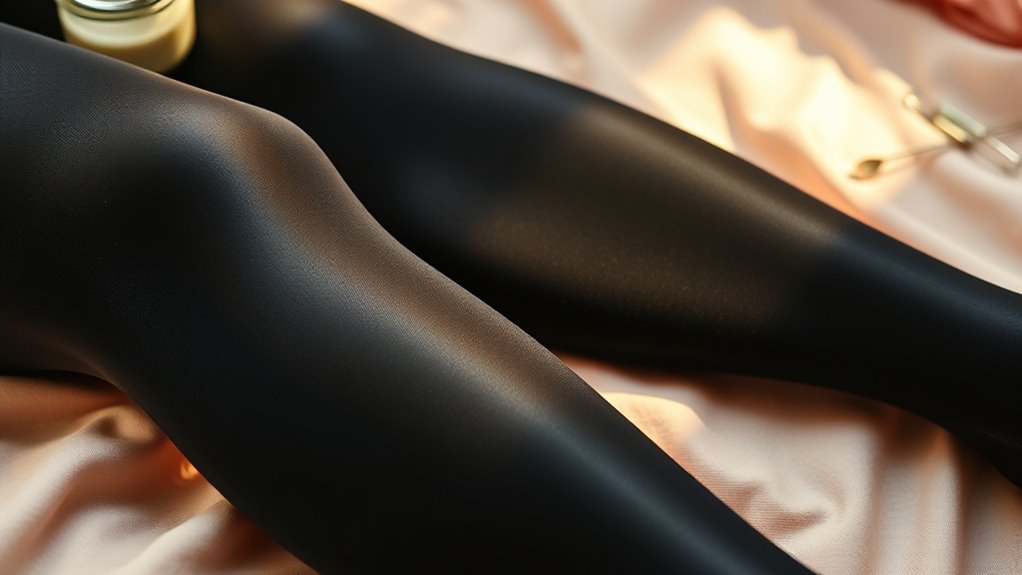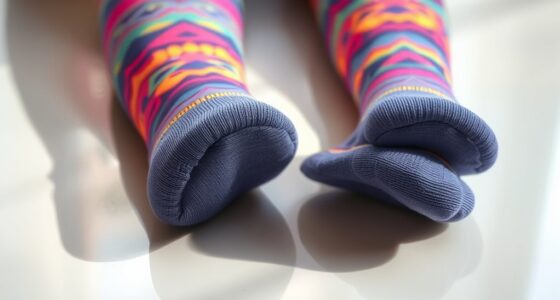To stretch your budget, choose durable tights made of nylon blends or spandex, and handle them with care. Wash them gently in cold water, inside out, using mild detergent, and air dry flat away from sunlight. Store them properly in small pouches or drawers to prevent snags, and avoid rough surfaces and sharp objects. Regularly check for wear and repair minor damage promptly. Keep these tips in mind to make your tights last longer and look new—learn more to maximize their lifespan.
Key Takeaways
- Choose durable fabrics like nylon blends and spandex to resist snags and tears, extending your tights’ lifespan.
- Turn tights inside out before washing and air dry to preserve elasticity, color, and prevent damage.
- Store tights carefully in pouches or compartments to avoid snags, tears, and fabric deterioration.
- Handle tights gently during application, using fingertips or hosiery gloves to prevent stretching and damage.
- Regularly inspect and repair small tears promptly to prevent worsening and prolong wearability.
Choosing the Right Tights for Longevity

Choosing the right tights from the start can considerably extend their lifespan. Focus on fabric selection to guarantee durability; look for thicker, high-quality materials like nylon blends or spandex that resist snags and tears. These fabrics tend to hold up better over time. When selecting tights, consider color coordination to minimize frequent dyeing or color mismatch, which can lead to quicker replacements. Neutral shades like black, navy, or beige are versatile and less prone to visible wear. Properly matching tights with your wardrobe not only enhances your look but also reduces unnecessary stress on the fabric. Additionally, choosing tights made with water-resistant fabrics can help prevent damage from moisture and extend their usability. Incorporating proper storage techniques can also significantly reduce wear and tear, prolonging their life and maintaining a polished appearance longer. Understanding fabric durability helps in selecting tights that will last longer and resist everyday damage. By choosing tights thoughtfully, you set a strong foundation for longevity, saving you money and maintaining a polished appearance longer.
Washing Your Tights Properly
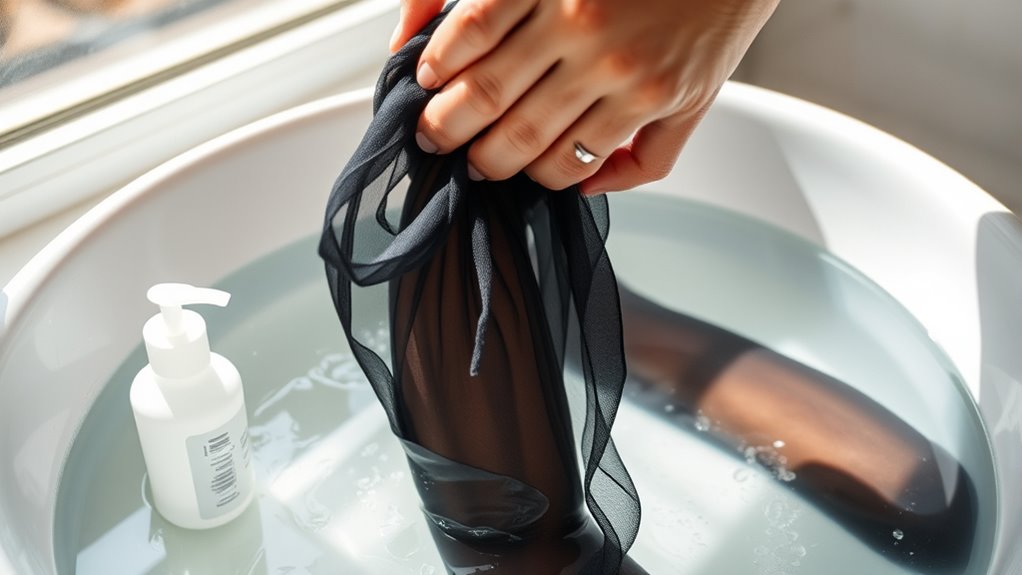
To keep your tights in great shape, it is essential to wash them carefully and correctly. Start by checking the fabric composition; delicate materials like nylon or spandex need gentle handling. Always turn tights inside out to protect the outer surface and prevent dye fading. Use cold water and a mild detergent to avoid damaging the fibers and preserve color vibrancy. Avoid bleach or fabric softeners, as they can weaken the fabric and cause dye to fade faster. Hand washing is ideal, but if you use a washing machine, place your tights in a mesh bag to minimize stretching and snagging. Proper washing not only maintains the elasticity but also preserves the dye, extending the life of your tights and keeping them looking fresh longer. Additionally, airflow around the tights during drying helps maintain their shape and elasticity. Incorporating gentle washing techniques can further help in protecting delicate fibers and prolonging garment life, especially when caring for stretchy materials. Using a gentle cycle on your washing machine can also reduce wear and tear on the fabric, ensuring your tights stay in good condition for longer. Paying attention to laundry care instructions can make a significant difference in maintaining their quality over time.
Drying Tights Effectively and Safely
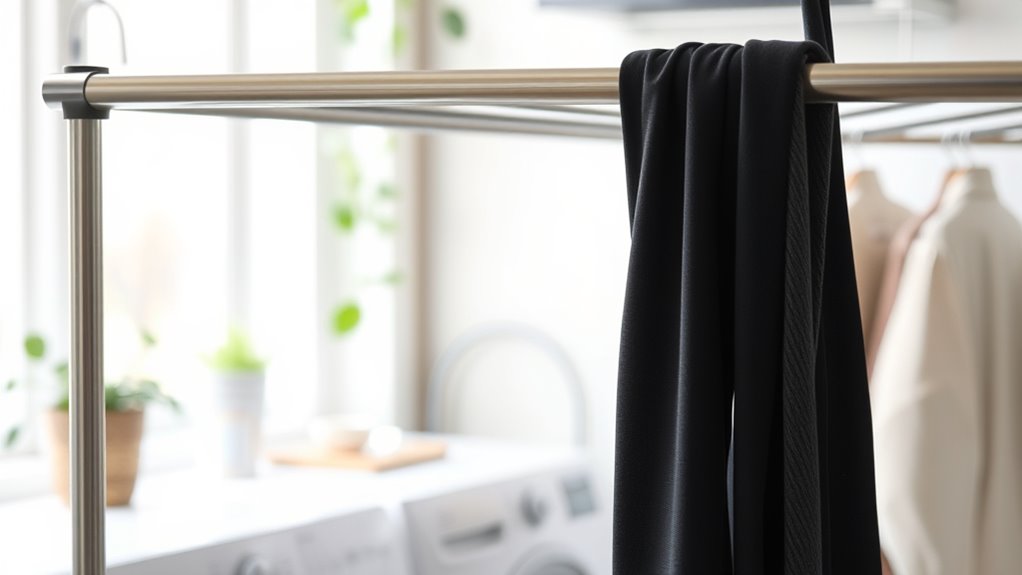
Properly drying your tights is essential to maintaining their shape and elasticity. To do this, use air drying methods, which avoid heat that can weaken fibers. Gently squeeze out excess water without twisting, then lay your tights flat on a clean towel or hang them on a drying rack. Additionally, air circulation is important to facilitate even drying and prevent musty odors. Avoid direct sunlight, as it can cause fading. To illustrate your options, consider this table:
| Method | Description |
|---|---|
| Flat drying | Lay tights flat on a towel to prevent stretching |
| Hanging | Hang on a drying rack, avoiding direct sunlight |
| Using a towel | Roll tights in a towel to absorb excess water |
| Avoid heat | Never use a dryer or radiators to dry tights |
| Patience | Allow ample time for natural air drying |
Being mindful of air quality can also help prevent the buildup of moisture and mold in storage areas, ensuring your tights stay fresh during drying. Additionally, choosing well-ventilated spaces can speed up the drying process and reduce moisture accumulation.
Storing Tights to Prevent Damage

To keep your tights in good shape, proper storage is essential. Make sure to fold them carefully to prevent snags, and store them in containers or pouches to avoid damage. Keep your tights away from sharp or rough items that could cause tears or runs. Using proper storage techniques can further extend their lifespan and maintain their appearance. Additionally, choosing storage options that prevent material degradation helps preserve the elasticity and overall quality of your tights over time. Incorporating mindfulness in organization can also protect your tights from unnecessary wear and tear. Being aware of how annuity features such as inflation adjustments work can serve as a reminder to periodically review and adjust your storage methods to align with the latest best practices.
Fold Carefully to Avoid Snags
Ever wondered how to prevent your tights from snagging or tearing? The key is folding them carefully. Gently smooth out any wrinkles and fold them flat, avoiding sharp creases that can catch on other items. Pay attention to fabric textures; some tights are more delicate, so handle them with extra care. When folding, keep the tights flat to prevent stretching or snagging, especially around the toes and waistband. Proper folding also helps with color maintenance, preventing fading or discoloration caused by unnecessary friction. Store your tights in a cool, dry place, away from rough fabrics or jewelry that could cause snags. Incorporating proper storage techniques can further extend their lifespan. Using correct folding methods reduces stress on the fibers, maintaining their elasticity and appearance over time. Additionally, choosing the right storage environment ensures that your tights remain in good condition longer. Being aware of pinball machine weights can help you choose the best storage solutions, especially if you have a collection. Taking these simple steps ensures your tights stay smooth, colorful, and damage-free longer, giving you more wear for your buck.
Use Storage Containers or Pouches
Using storage containers or pouches is an effective way to protect your tights from damage. They help keep your hosiery organized and prevent snags or tears caused by loose items in your drawer. By storing tights separately, you avoid tangling and make clothing organization much easier. Pouches or small containers are especially useful for space-saving tips, allowing you to maximize drawer space while keeping your tights in pristine condition. Choose breathable pouches to prevent moisture buildup, which can weaken fabric fibers. Labeling containers can also streamline your wardrobe routine. Proper storage not only extends the life of your tights but also saves you time searching for matching pairs. Implementing these simple tips ensures your tights stay in top shape, ready to wear whenever you need them.
Keep Away From Sharp Items
Sharp objects like scissors, pins, or jewelry can easily snag or tear your tights if stored nearby. To prevent damage, keep these items separate from your hosiery. Jewelry contact, especially rings or bracelets, can cause minor snags that worsen over time. Store your tights in a safe container away from sharp or hard objects. Consider using a dedicated drawer organizer with compartments. Here’s a visual to help:
| Item | Storage Tip |
|---|---|
| Scissors | Keep in a separate box or drawer |
| Pins | Use a pin cushion or small container |
| Jewelry (rings, bracelets) | Store in jewelry box or pouch |
| Sharp tweezers | Place in a different compartment |
| Hard jewelry pieces | Keep isolated from tights in storage |
This keeps your tights smooth and snag-free.
Handling and Wearing Tights With Care
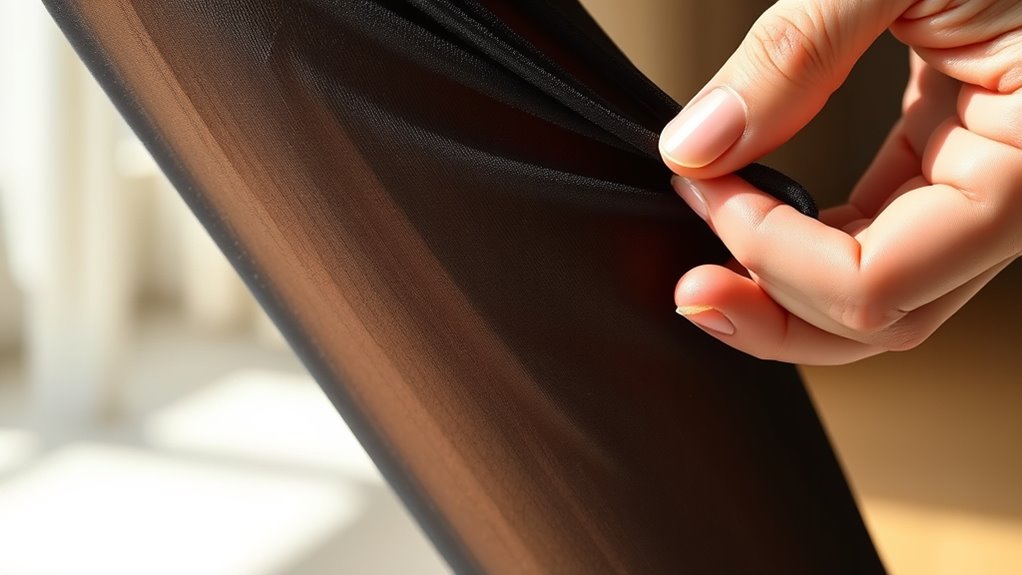
Handling and wearing tights with care is essential to prevent tears and extend their lifespan. Start by choosing fabric patterns that are less prone to snagging, such as smooth, matte finishes. When putting on tights, gently gather them from the toes upward, avoiding excessive pulling or stretching. Pay attention to your outfit’s color coordination; pairing tights with complementary colors reduces the need for frequent removal or adjustment, minimizing stress on the fabric. Be mindful of jewelry or accessories that could snag the material. Always handle tights carefully during dressing and undressing, keeping nails smooth and avoiding sharp objects nearby. By treating your tights with care, you’ll preserve their appearance and elasticity, helping them last longer and saving you money in the long run.
Repairing Small Tears and Runs
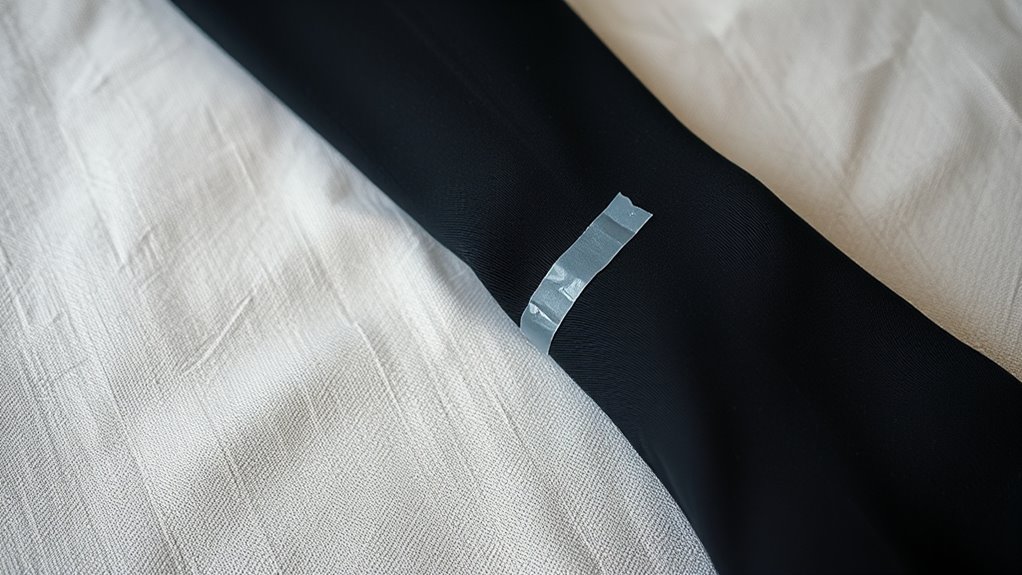
When you notice small tears or runs in your tights, acting quickly can prevent them from worsening. To repair, try patching holes with clear nail polish or sewing a tiny piece of fabric over the tear. Reinforcing seams with a quick stitch can also stop tears from spreading. Here’s a helpful guide:
| Step | Action |
|---|---|
| Identify the tear or run | Examine and locate the damage |
| Clean the area | Make sure it’s dry and free of lint |
| Patch or reinforce | Use fabric or clear nail polish for small repairs |
| Sew small tears | Use a fine needle and matching thread to reinforce seams |
| Allow to dry or set | Let the repair sit before wearing again |
This simple approach can extend your tights’ life and keep them looking neat.
Avoiding Common Tights Pitfalls
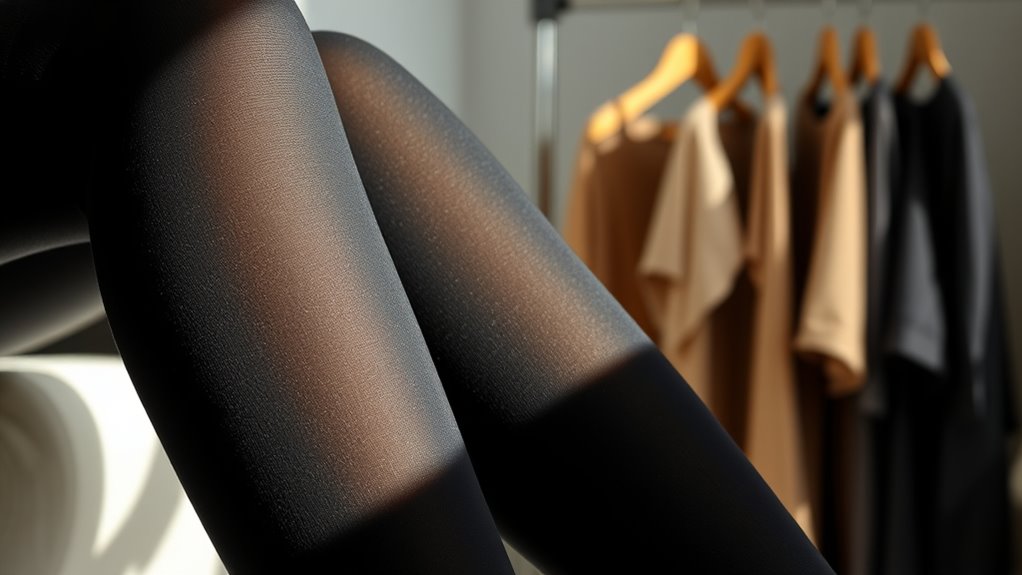
To keep your tights looking their best, it is essential to recognize and avoid common pitfalls that can cause damage or shorten their lifespan. One mistake is ignoring fabric patterns and choosing tights with delicate or intricate designs that snag easily. Be mindful of rough surfaces or jewelry that can catch on the fabric. Additionally, poor color coordination can lead to mismatched outfits, encouraging you to wear tights that clash or stain easily. Always check the tights for any signs of wear before putting them on, and avoid pulling or stretching them excessively, which can cause runs. Proper handling and thoughtful outfit planning can prevent unnecessary tears and guarantee your tights stay in good shape longer.
Using the Right Accessories and Techniques

Using the right accessories and techniques can extend your tights’ lifespan. Proper storage keeps them from snagging or stretching out, while gentle application prevents tears. Small adjustments like these make a big difference in keeping your tights looking their best.
Proper Storage Solutions
Proper storage is essential for keeping your tights in good shape and extending their lifespan. The right storage environment prevents snags, stretching, and fabric damage. To protect your tights fabric, avoid hanging them on sharp hooks or rough surfaces. Instead, fold your tights gently and store them in a drawer or storage box. Use dividers or small pouches to keep pairs separate, preventing tangling and fabric snags. Keep your storage environment cool, dry, and away from direct sunlight, which can weaken the tights fabric over time. Avoid overcrowding your drawers, as tight compression can cause stretching or fabric thinning. By choosing the right accessories and techniques, you ensure your tights stay smooth, snag-free, and ready for wear when you need them.
Gentle Application Methods
Applying tights gently is key to preventing tears and snags, and the right accessories can make all the difference. Use your fingertips instead of your nails to avoid damaging the delicate fabric texture. When putting them on, step into the tights rather than pulling them up quickly, which can cause stretching and color fading over time. Consider using a hosiery glove or a cotton sock to help smooth the fabric smoothly over your legs, reducing friction that can lead to snags. Avoid pulling or tugging aggressively, especially around the toes and waistband. Taking these careful steps ensures your tights stay intact longer, maintaining their color and texture. Gentle application techniques protect your investment and help your tights look their best for multiple wears.
Extending Tights’ Lifespan With Proper Use

To make your tights last longer, it is vital to handle them carefully during wear and care. Proper use preserves material flexibility and prevents unnecessary color fading. When putting on tights, gently step into them rather than pulling harshly, which can stretch fibers and cause runs. Avoid exposing them to rough surfaces or sharp objects that damage the fabric. To evoke emotion and remind yourself of their delicate nature, consider this:
| Handling with Care | Materials Matter | Lasting Brightness |
|---|---|---|
| Gentle donning | Choose quality | Wash inside out |
| Avoid pulls | Flexibility retains | Air dry |
| No sharp objects | Prevents color fade | Keep vibrant |
Treat your tights with care, and they’ll serve you longer, looking fresh and flexible every wear.
When and How to Replace Your Tights

You should replace your tights when you notice signs of wear like tears or thinning fabric. How often you wear them and how you store them also affect their lifespan. Pay attention to these factors to know the right time to say goodbye and keep your wardrobe fresh.
Signs of Wear
Have you ever wondered how to tell when your tights need replacing? Recognizing wear is key to making them last. First, check for fabric patterns that have become distorted or stretched out, which indicate loss of elasticity. Second, look for color fading, especially in areas that see frequent friction; this signals the tights are losing their vibrancy and integrity. Third, inspect for small tears or runs that worsen over time, compromising durability. These signs suggest it’s time to retire your tights and avoid potential embarrassment or discomfort. Keeping an eye on fabric patterns and color fading helps you decide when to replace your tights promptly, ensuring your wardrobe stays fresh and your look stays polished without unnecessary expenses.
Frequency of Use
Wondering how often to replace your tights? The answer depends on how frequently you wear them and how well you care for them. Generally, tights should be replaced every 3 to 6 months if worn regularly, especially if you notice signs of thinning or small runs. To maximize their lifespan, consider color coordination—rotating different shades prevents overuse of one pair. Seasonal rotation also helps; save your thicker tights for winter and lighter ones for summer to reduce wear. Pay attention to how often you wear each pair, and replace those that show signs of fatigue to avoid unexpected tears. By adjusting your usage and rotation habits, you’ll extend the life of your tights and get the most out of your investment.
Proper Storage Techniques
Proper storage techniques are essential to keep your tights in good condition and to know when it’s time to replace them. To maintain fabric quality, pay attention to your storage environment. Here are three tips:
- Store tights in a cool, dry place away from direct sunlight to prevent fabric degradation.
- Fold them gently and avoid hanging, which can stretch the fabric and cause sagging.
- Use breathable containers, like mesh bags or cotton pouches, to protect against snags and dust.
These practices help preserve elasticity and prevent damage, allowing your tights to last longer. Regularly inspect them for signs of wear, such as thinning or holes, to determine if it’s time for replacement. Proper storage guarantees your tights stay in top shape and saves you money in the long run.
Frequently Asked Questions
How Can I Tell if My Tights Are Truly High-Quality?
You can tell if your tights are high-quality by checking their fabric composition and brand reputation. Look for tights made from durable materials like nylon and spandex, which offer stretch and longevity. Additionally, research brands known for quality craftsmanship and positive reviews. High-quality tights feel smoother, fit better, and resist runs longer. If your tights are from a reputable brand and made with strong fabrics, they’re likely to last and provide good value.
Are There Specific Detergents Best for Delicate Tights?
When it comes to detergent selection for delicate fabric like tights, you want a gentle, mild detergent. Look for products specifically labeled for delicate or fine fabrics, as they prevent damage and preserve elasticity. Avoid harsh chemicals, bleach, or strong fragrances that can weaken the fibers. Using a mild detergent helps keep your tights soft, stretchy, and in good condition longer, ensuring you get the most out of your investment.
What Are the Signs That My Tights Need Replacing?
Like a whisper fading into silence, your tights show signs when they need replacing. If you notice persistent pilling despite pilling prevention efforts, or if colors start to fade even after gentle washes, it’s time to say goodbye. Thin areas, runs, or holes also signal deterioration. Don’t ignore these signs—they’re your tights’ way of telling you they’ve reached the end of their lifespan.
Can Certain Footwear Damage My Tights Over Time?
Certain footwear can damage your tights over time, especially if there’s poor footwear compatibility. Shoes with rough or sharp edges, like some leather or high heels, can snag or run your tights. Shoe material impact matters too; stiff soles or pointed toes may cause friction. To protect your tights, choose shoes with smooth interiors and avoid tight-fitting footwear. Properly matching your footwear with your tights helps prevent unnecessary tears and extends their lifespan.
How Often Should I Inspect My Tights for Damage?
You should inspect your tights regularly, ideally after each wear, to catch any damage early. Proper tights storage and seasonal rotation can help prevent tears and runs. Check for snags, holes, or thinning areas, especially around the toes and heels. By doing this, you extend their lifespan, maintain their appearance, and avoid surprises when you put them on. Regular inspections keep your tights looking fresh and lasting longer.
Conclusion
By following these care tips, your tights can last much longer. For example, imagine you wear the same pair for a week of daily workouts—they stay intact and look new. Proper washing, gentle handling, and smart storage prevent tears and snags. With a little extra effort, you’ll save money and enjoy your favorite tights season after season. Just think of your tights as a valuable wardrobe investment that deserves some TLC!
